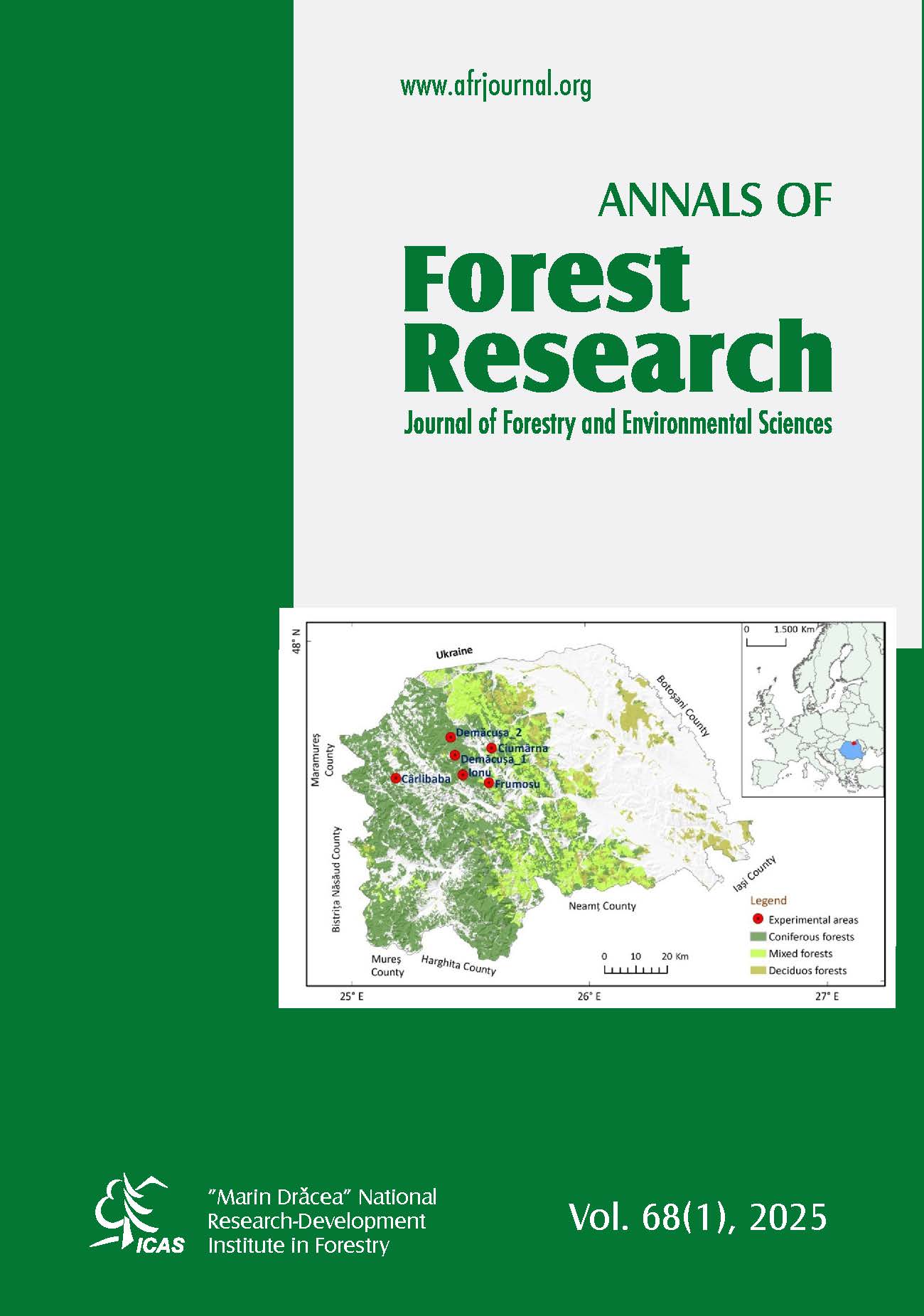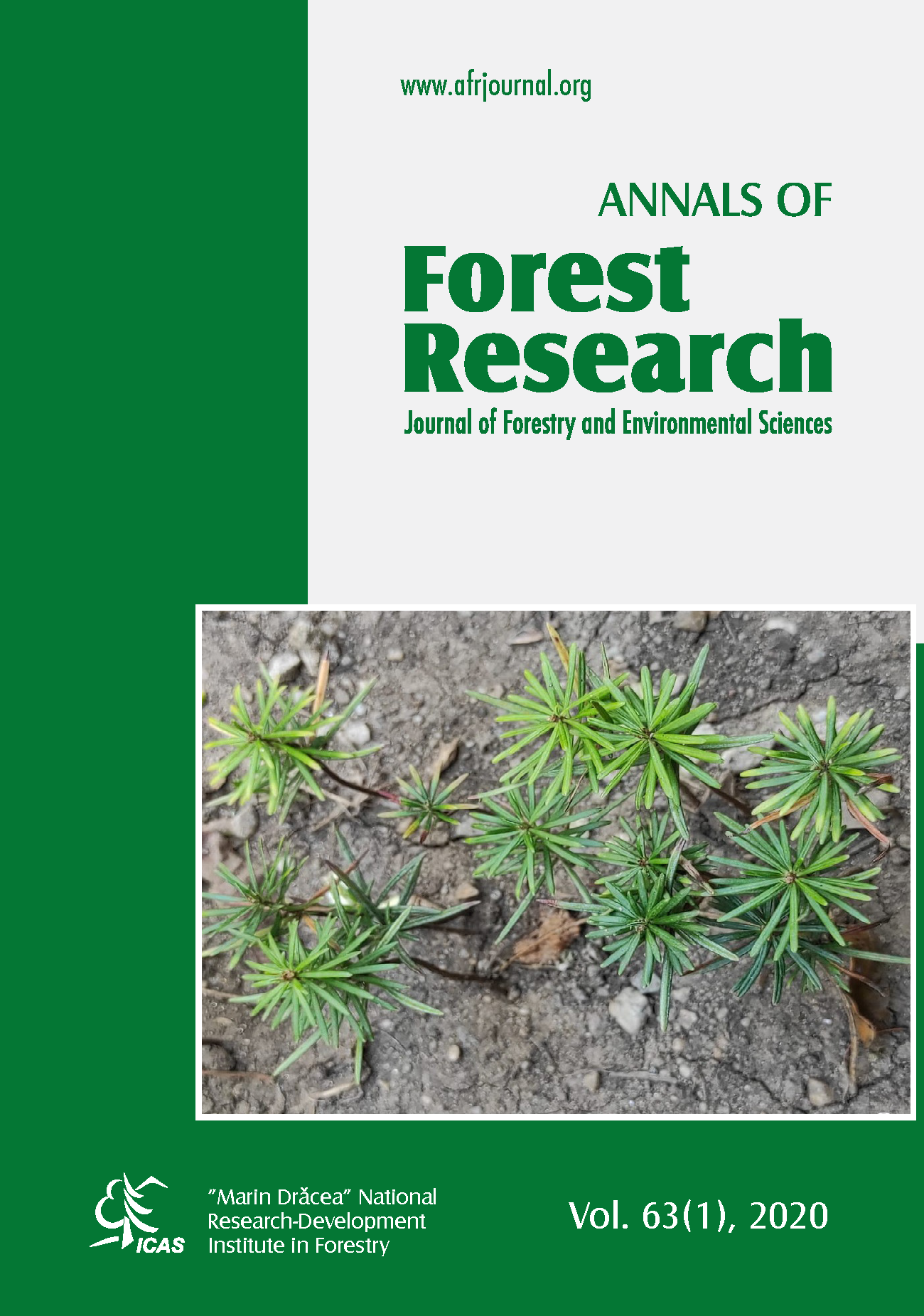Variation in strobilus and cone production in clonal seed orchards of Anatolian black pine
DOI:
https://doi.org/10.15287/afr.2025.3751Keywords:
clone, genetic variation, heritability, reproductive characters, seed orchardsAbstract
Anatolian black pine [Pinus nigra Arnold subsp. pallasiana (Lamb.) Holmboe] is an economically and ecologically important forest tree species with a natural distribution of 4.2 million ha, 32% of which is unproductive due to forest fire and other damages in Turkish forestry. The species is widely used in afforestation and conversion of unproductive forests by deploying genetically improved seed from seed orchards because of high adaptation capability to various environmental conditions, and a target species of national tree breeding programme of Anatolian black pine. Estimated variation in reproductive characters can be used as an important guide for managing of seed orchards. The number of cones, female and male strobili were studied in three seed orchards established in 1991, 1993 and 1985 composed of 30, 30 and 34 clones each. Five grafts of each clone were evaluated from each seed orchard for three consecutive years (2022-2024). This study estimated the variation of broad-sense heritability (H2) and the correlation among cone and strobili production at the graft and clone level. Positive and significant (p<0.05) relations were calculated between female and male strobili within year in all orchards both ramet and clone levels, together with significant (p<0.05) relations among years for cone productions in the orchards. Significant (p<0.05) differences were found for the characters among clones and among years within orchard. Year x clone and clone x ramet interactions were generally significant (p<0.05) for the characters. Female strobili seemed a good predictor for cone production. However, the heritability in broad sense was mostly on average below 0.5 for the characters in each seed orchard except of female strobili in an orchard in year-24. It indicated that the reproductive characters under environmental control, and they could give to reflect to management practices.
References
Almqvist C., Jansson G., and Sonesson, J., 2001. Genotypic correlations between early cone-set and height growth in Picea abies clonal trials. Forest Genetics, 8, 197-204. https://kf.tuzvo.sk.
Atalay İ., Efe, R., 2012. Ecological attributes and distribution of Anatolian black pine [Pinus nigra Arnold. subsp. pallasiana Lamb. Holmboe] in Turkey. Journal of Environmental Biology, 33, 509-519. www.jeb.co.in.
Ayan S., Yer E.N., Gulseven O., 2017. Evaluation of Taurus cedar (Cedrus libani A. Rich.) afforestation areas in Turkey in terms of climate type. Journal of Forestry Faculty of Artvin Coruh University, 18, 152-161. https://doi.org/10.17474/artvinofd.305038.
Bilir N., 2002. Clonal repeatabilities for female and male flowering in seed orchards of pines in Turkey. Symposium of Population and Evolutionary Genetics of Forest Trees, August 25-29, Zvolen, p. 74.
Bilir N., Kang K.S., Ozturk, H., 2002. Fertility variation and gene diversity in clonal seed orchards of Pinus brutia, Pinus nigra and Pinus sylvestris in Turkey. Silvae Genetica, 51(2-3), 112-115. https://doi.org/10.1515/sg-2004-0029.
Bilir N., Kang K.S., Lindgren D., 2005. Fertility variation in six populations of Brutian pine (Pinus brutia Ten.) over altitudinal ranges. Euphtyica, 141, 163-168. https://doi.org/10.1007/s10681-005-6803-6.
Bilir N., Prescher F., Ayan S., Lindgren D., 2006. Growth characters and number of strobili in clonal seed orchards of Pinus sylvestris. Euphytica, 152, 1-9. https://doi.org/10.1007/s10681-006-9216-2.
Bilir N., Prescher F., Lindgren D., Kroon, J., 2008. Variation in cone and seed characters in clonal seed orchards of Pinus sylvestris. New Forests, 36, 187-199. https://doi.org/10.1007/s11056-008-9092-9.
Eriksson G., Jonsson A., Lindgren D., 1973. Flowering in a clone trial of Picea abies. Studia Forestalia Suecica, 110, 1-45.
Ertekin M., 2010. Clone fertility and genetic diversity in a Black pine seed orchard. Silvae Genetica, 59, 145-150.
Gaussen H., Heywood V. H., Cheter A. O., 1964. The Genus Pinus in Flora of Eoropea. Vol. I, Publisher of Camridge.
Hannerz M., Aitken S., Ericsson T., Ying C.C. 2001. Inheritance of strobili production and genetic correlation with growth in lodgepole pine. Forest Genetics, 8, 323-329. https://kf.tuzvo.sk .
Hedegart T., 1976. Breeding systems, variation and genetic improvement of teak. Tropical trees: Variation, Breeding and Conservation Linnean Society Symposium Series:2, New York.
Jeon K., Ro H.S., Kim Y.J., Gu D.E., Park J.M., Ryu S., Kang K.S., 2022. Genetic variation of flower production in breeding seedling seed orchards of Quercus acuta and Q. glauca. Journal of Forest and Environmental Science, 38(2), 102-109. https://doi.org/10.7747/JFES.2022.38.2.102.
Kang K.S. 2001. Genetic gain and gene diversity of seed orchard crops. PhD Thesis. Swedish University of Agricultural Science, Umeå, Sweden. Acta Universitatis Agriculturae Sueciae. Silvestria, 187, p. 75. https://www.upsc.se.
Kang K.S., 2000. Clonal and annual variation of flower production and composition of gamete gene pool in a clonal seed orchard of Pinus densiflora. Canadian Journal of Forest Research, 30(8), 1275-1280. https://doi.org/10.1139/x00-060.
Kang K.S., Bilir N., 2021. Seed orchards (Establishment, Management and Genetics). OGEM-VAK Press, Ankara.
Kim Y.J., Park J.M., Gu D.E., Yeom D.B., Kang H.I., Kang K.S., 2024. Flowering variation and its effect on the gene diversity of seed crops in a clonal seed orchard of Pinus koraiensis Siebold et Zucc. Scandinavian Journal of Forest Research, 39(2), 119-126. https://doi.org/10.1080/02827581.2023.2295887.
Kjær E.D., 1996. Estimation of effective population number in a Picea abies (Karst) seed orchard based on flower assessment. Scandinavian Journal of Forest Research, 11(2), 111-121. https://doi.org/10.1080/02827589609382918.
Koski V., Antola J., 1993. National Tree Breeding and Seed Production Programme for Turkey 1994-2003. The Research Directorate of Forest Tree Seeds and Tree Breeding, 52 pp., Ankara, Turkey. www. ortohum.gov.tr) (Date of access: 10.08.2021).
Matziris D., 1993. Variation in cone production in a clonal seed orchard of Black pine. Silvae Genetica, 42, 136-141.
Matziris D., 1997. Variation in growth, flowering and cone production in a clonal seed orchard of Aleppo pine grown in Greece. Silvae Genetica, 46, 224-228. https://www.thuenen.de.
Matziris D., 1998. Genetic variation in cone and seed characteristics in a clonal seed orchard of Aleppo pine grown in Greece. Silvae Genetica, 47, 37-41. https://www.sauerlaender-verlag.com.
Nikkanen T., Ruotsalainen S., 2000. Variation in flowering abundance and its impact on the genetic diversity of the seed crop in a Norway spruce seed orchard. Silva Fennica, 34, 205-222. https://doi.org/10.14214/sf.626.
OGM, 2024. Forestry Statistics-2023. www.ogm.gov.tr. Turkiye, Ankara (www.ogm.gov.tr) Date of access: 1.07.2024).
ORTOHUM, 2024. Website of the Research Directorate of Forest Tree Seeds and Tree Breeding (www. ortohum.gov.tr) (Date of access: 06.11.2024).
Rohlf F.J., Sokal R.R., 1995. Statistical Tables. Macmillan: pp. 18.
Saatçioğlu F., 1976. Introduction to Silviculture (Silviculture-I). Forestry Faculty of Istanbul University press, Istanbul.
SAS, 2004. Statistical Analysis System, SAS Institute, Inc. Cary., N.C., USA. https://www.sas.com
Savolainen O., Karkkainen K., Harju A., Nikkanen T., Rusanen M., 1993. Fertility variation in Pinus sylvestris: a test of sexual allocation theory. American Journal of Botany, 80, 1016-1020. https://doi.org/10.1002/j.1537-2197.1993.tb15328.x.
Schmidtling R.C., 1983. Genetic variation in fruitfulness in a loblolly pine (Pinus taeda L.) seed orchard. Silvae Genetica, 32(3-4), 76-80. https://www.thuenen.de.
Schultz R.P., 1971. Stimulation of flower and seed production in a young slash pine orchard. U.S. Southeastern For. Exp. Station. USDA Forest Service, SE-91, 10 p., USA.
Van Haverbeke D.F., 1990. Pinus nigra Arnold European black pine. Silvics of North America, 1, 395-404.
Varghese M., Nicodemus A., Nagarajan B., Lindgren D., 2006. Impact of fertility variation on gene diversity and drift in two clonal seed orchards of teak (Tectona grandis Linn. f.). New Forests, 31, 497-512. https://doi.org/10.1007/s11056-005-2178-8.
Zobel B.J., Barber J., Brown C.L., Perry T.O., 1958. Seed orchards-their concept and management. Journal of Forestry, 56, 815-825. https://doi.org/10.1093/jof/56.11.815.
Zobel B.J., Talbert J., 2003. Applied Forest Tree Improvement. John Wiley and Scons, New York, England, pp. 505.
Downloads
Published
Issue
Section
License
All the papers published in Annals of Forest Research are available under an open access policy (Gratis Gold Open Access Licence), which guaranty the free (of taxes) and unlimited access, for anyone, to entire content of the all published articles. The users are free to "read, copy, distribute, print, search or refers to the full text of these articles", as long they mention the source.
The other materials (texts, images, graphical elements presented on the Website) are protected by copyright.
The journal exerts a permanent quality check, based on an established protocol for publishing the manuscripts. The potential article to be published are evaluated (peer-review) by members of the Editorial Board or other collaborators with competences on the paper topics. The publishing of manuscript is free of charge, all the costs being supported by Forest Research and Management Institute.
More details about Open Access:
Wikipedia: http://en.wikipedia.org/wiki/Open_access






